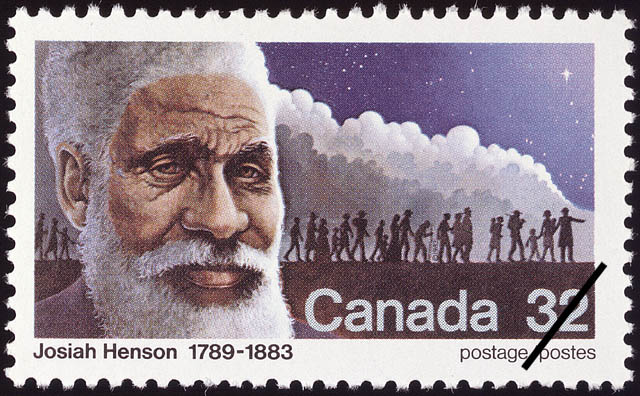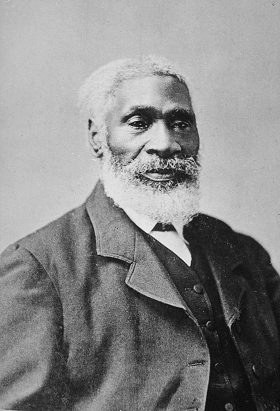"You see those trees," said the noble-hearted captain, next morning, pointing to a group in the distance; "they grow on free soil, and as soon as your feet touch that, you're a man..." Never shall I forget the spirit in which he spoke. He put his hand on my head and said, "Be a good fellow, won't you?..." "Yes," said I; "I'll use my freedom well..."
(An Autobiography of Josiah Henson From 1789 to 1883, page 94)

Uncle Tom's Cabin in Dresden, Ontario courtesy blackburnnews.com.
"I'll Use my Freedom Well" is the title of the exhibit at Uncle Tom's Cabin located in Dresden, Ontario, based on the real life of escaped slave, Josiah Henson. Far from the "yes man" that whites of the era interpreted Harriet Beecher Stowe's character, Josiah Henson was a devout Christian who forged a strong identity as a preacher, abolitionist, author and conductor of the Underground Railroad.
Josiah Henson, the son of slave tobacco farmers, was born in Maryland in 1789. One of his early memories was of his father bleeding profusely after standing up to his slave owner, who had tried to rape his wife; his punishment was a 100 lash whipping and a lopping off of an ear.
Josiah's parents' master died and he and his siblings were sold to different slave owners. Josiah's mother protested and her owner, Isaac Riley, relented, buying back Josiah. The young man proved to be an asset at the farm; the slave owner eventually made him supervisor of the other slaves. In the meantime, Riley fell on hard times and asked Josiah to deliver the eighteen slaves to his brother's farm where they would work. Keeping his word, Josiah, carried out his master's orders, even though others wondered why he didn't use this chance to spear head an escape.
In 1828, Josiah returned to his master's farm and asked if he could buy his freedom. He presented Riley with $350 with a note promising the remaining $100. Riley said he would release Josiah upon receipt of the remaining money and Josiah took his word. However, in the meantime his master added an additional "0" to the note making the sum $1000.
Cheated out of his freedom, Josiah now planned his escape. In 1830, he and his wife, along with their four children, fled Kentucky along the Underground Railroad, which had been operating already for about 25 years. On the far shore of the Niagara River, the family found freedom.
Josiah found work on a farm just outside of Fort Erie. Later he found work in Waterloo. Black Loyalists from the Revolutionary War and refugees from the War of 1812 had already settled parts of Upper Canada. Josiah, too, became a loyal British subject, helping to quell the Rebellion of 1837 as part of a black militia unit.
Finally, in 1841, Josiah purchased land in Dawn Township near Dresden, Ontario for a self-sufficient black settlement. He and fellow escaped slaves worked the land and felled the trees. They developped a successful lumber industry, exporting black walnut to the United States and Britain.
Josiah became a minister, preaching at the British Methodist Episcopal Church in Dresden every Sunday. While his mother had been illiterate, she did teach him the Lord's Prayer and some old spiritual hymns which he likely sang when he travelled the Underground Railroad. Josiah had listened to other preachers and memorized verses from the Bible.
Josiah did not turn his back on America, however. He made trips back to the United States as a conductor of the Underground Railroad, leading escaped slaves to freedom as someone had once led him to "the Promised Land". His trips from Tennessee to what later became Ontario would be dangerous journeys in which he could have been captured and resold into slavery. He spoke often about the abolitionist cause in Canada and the United States.

Canadian stamp circa 1983 courtesy staticflickr.com.
Josiah and his wife went on to have a total of 12 children. Josiah believed in education and he made sure each of his children received schooling in the Dawn settlement. However, Josiah himself had never learned to read or write. When his son turned 12, he offered to teach his father the alphabet and Josiah readily accepted.
Josiah became such a strong reader that he started writing. In 1849, he penned his memoirs, The Life of Josiah Henson, Formerly a Slave, Now an inhabitant of Canada, As Narrated by Himself. Josiah travelled widely, promoting his book and using the proceeds to finance the Dawn Settlement which now had its own industrial training school. Reading his autobiography inspired Harriet Beecher Stowe to create her famous character, Uncle Tom.
In 1851, Josiah sailed to England to promote his book and to speak about abolition. At the Crystal Palace World's Fair, he met none other than Queen Victoria. On a return visit in 1866, the Queen received him at her castle. On the occasion, he met the Archbishop of Canterbury who asked him: "At what university, sir, did you graduate?" Josiah replied: "I graduated, sir, at the university of adversity." The archbishop could not believe that he did not have a formal education since he spoke so eloquently. Josiah explained that over the years he had made a point of observing good speakers and modelling his speech after them.
Josiah lived out his last years in Dresden, continuing to preach every Sunday at the Methodist church. Some of the Dawn settlers returned to the United States after the Civil War when slavery was abolished. However, Josiah chose to remain in Canada. He passed away on May 5, 1883, at the age of 93, surrounded by his children, grandchildren and great-grandchildren. He is buried in a cemetery adjacent to the museum, his tombstone topped with a crown, a nod to Queen Victoria.
Note: Josiah Henson's home was purchased by the Canadian government and made into a museum in 1940. In 1983, Josiah Henson became the first black Canadian to be featured on a Canadian stamp. Many books have been written about the hero including a recent account by Jacqueline Tobin, From Midnight to Dawn: The Last Tracks of the Underground Railroad. Midnight was the code name for Detroit; Dawn, of course, was the settlement outside of Dresden.

Josiah Henson circa 1877 courtesy http://en.wikipedia.org/wiki/Josiah_Henson.
No comments:
Post a Comment